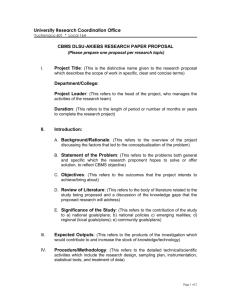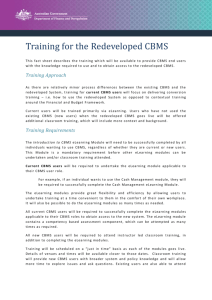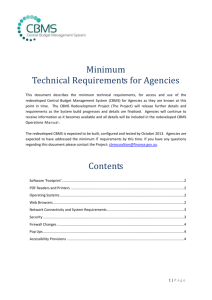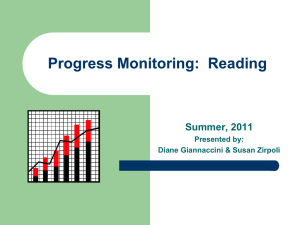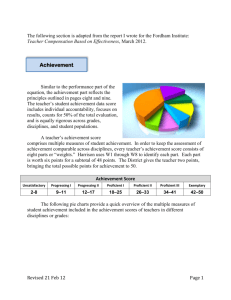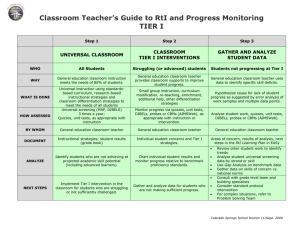PAGE-CBMS Research Grants Manual
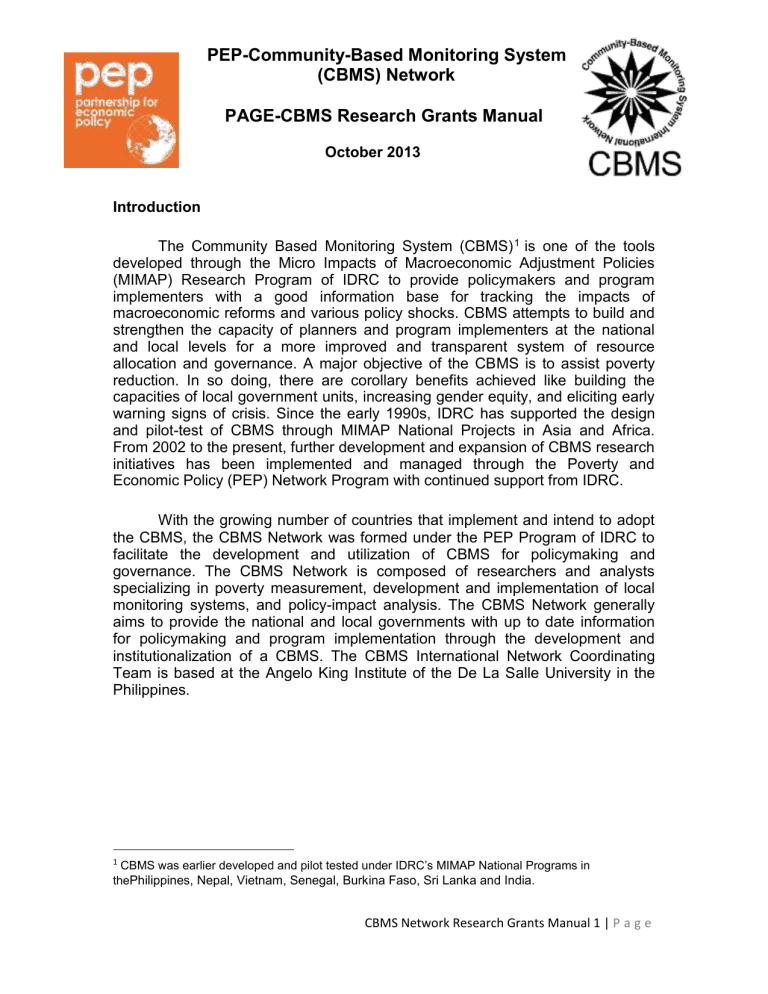
PEP-Community-Based Monitoring System
(CBMS) Network
PAGE-CBMS Research Grants Manual
October 2013
Introduction
The Community Based Monitoring System (CBMS) 1 is one of the tools developed through the Micro Impacts of Macroeconomic Adjustment Policies
(MIMAP) Research Program of IDRC to provide policymakers and program implementers with a good information base for tracking the impacts of macroeconomic reforms and various policy shocks. CBMS attempts to build and strengthen the capacity of planners and program implementers at the national and local levels for a more improved and transparent system of resource allocation and governance. A major objective of the CBMS is to assist poverty reduction. In so doing, there are corollary benefits achieved like building the capacities of local government units, increasing gender equity, and eliciting early warning signs of crisis. Since the early 1990s, IDRC has supported the design and pilot-test of CBMS through MIMAP National Projects in Asia and Africa.
From 2002 to the present, further development and expansion of CBMS research initiatives has been implemented and managed through the Poverty and
Economic Policy (PEP) Network Program with continued support from IDRC.
With the growing number of countries that implement and intend to adopt the CBMS, the CBMS Network was formed under the PEP Program of IDRC to facilitate the development and utilization of CBMS for policymaking and governance. The CBMS Network is composed of researchers and analysts specializing in poverty measurement, development and implementation of local monitoring systems, and policy-impact analysis. The CBMS Network generally aims to provide the national and local governments with up to date information for policymaking and program implementation through the development and institutionalization of a CBMS. The CBMS International Network Coordinating
Team is based at the Angelo King Institute of the De La Salle University in the
Philippines.
1 CBMS was earlier developed and pilot tested under IDRC’s MIMAP National Programs in the Philippines, Nepal, Vietnam, Senegal, Burkina Faso, Sri Lanka and India.
CBMS Network Research Grants Manual 1 | P a g e
CBMS Norm
The CBMS is an organized way of collecting household level information at the local level. However, CBMS is more than just a data collection system. It seeks to integrate the use of data in local level planning and program implementation. In particular, CBMS intends to fill information gaps for diagnosing the extent of poverty at the local level, determining the causes of poverty, formulating policies and programs, identifying eligible program beneficiaries, and assessing impact of policies and programs. It is intended to promote evidence-based decision-making.
CBMS is local government unit (LGU)-based while promoting community participation; (2) it taps existing LGU personnel and community volunteers as monitors; and (3) it has a core set of indicators.
CBMS work involves the design, pilot-test and implementation of a methodology for data collection and data processing, validation and utilization of
CBMS data for needs identification as well as for the design and monitoring of program interventions at all geopolitical levels. The CBMS research initiative of
PEP complements global efforts to fight poverty by providing better statistics or benchmark information for evidence-based policymaking while empowering communities and development leaders in the process and in turn promoting accountability for better management and greater transparency in allocation of resources.
1.0. Call for Project Proposals
Supported by the International Development Research Centre (IDRC)-
Canada and the Department for International Development (DFID) of the United
Kingdom, the Angelo King Institute for Economic and Business Studies of De La
Salle University Manila through the PEP-CBMS Network provides research grants of up to US$ 50,000 to qualified institutions in developing countries for the development and pilot-test of CBMS indicators, methodologies and instruments.
Funding support is also provided for advanced CBMS work relating to CBMS data analysis and applications, and institutionalization of CBMS initiative.
Application is open to research and academic institutions as well as to other government and non-government organizations involved in policy research and related poverty monitoring and reduction initiatives. The research team members should have university-level training in economics/policy analysis or equivalent experience. The research team should consist of at least 50 percent females.
The Network, however, does not accept new proposals for establishing such a
CBMS in the Philippines since it is already being scaled up in the said country.
Aside from the financial support for the conduct of CBMS research, grantees are provided with opportunities to participate in the CBMS and PEP network training workshops and conferences, organized study visits to CBMS sites, and are also given access to the PEP-CBMS network database as well as
CBMS Network Research Grants Manual 2 | P a g e
technical support from the network’s pool of technical resource persons.
An open call for proposals is mainly done electronically through the CBMS and PEP network web-site at www.pep-net.org. Proponents whose research proposals have passed the initial screening by the CBMS Program Committee are invited to participate in a pre-scheduled interim meeting/training workshop of the CBMS network. It is in the said activity where potential grantees are able to learn from on-going CBMS initiatives, and interact with existing network members and its pool of resource persons, and obtain the necessary basic tools for the development of a more detailed proposal on CBMS.
Institutions that are interested to submit a proposal may follow the guidelines and format in Annex A .
2.0 Review and Approval of Grant Applications
The review process of CBMS Proposals usually takes 6 to 12 months before the formal approval of a Project. The duration of the review process depends on the quality of the initial proposals submitted and the capacity of the
Proponent Institution to revise the original proposal based on the set of comments from the CBMS Network Program Committee. The project will commence immediately once the revised proposal is approved by the program committee.
The process of grant applications and review are as follows:
1. Proponents submit a research proposal to the CBMS International
Network Coordinating Team for initial screening.
2. If the proposal lacks some important basic elements based on the set criteria, the proposal is sent back to the proponents for revision.
3. Upon submission of revised proposal to the CBMS International
Network Coordinating Team, said document is circulated to the members of the CBMS Program committee for further review.
4. Comments of the members of the Program Committee on the proposals are then consolidated by the CBMS International
Network
CBMS Network Research Grants Manual 3 | P a g e
CBMS Network Research Grants Manual
Coordinating Team, and in turn sent to the proponents for consideration in finalizing their proposal.
4
5. Upon receipt of the final proposal, the CBMS International Network
Coordinating Team sends the aforementioned document to the members of the CBMS Steering Committee for final recommendations for approval.
6. Once grant applications are approved by the Committee, proponents are notified and sent a draft grant contract for review
7. An initial grant payment is released once the grant contract has been signed by all parties concerned.
2.1. Review and Coordinating Bodies
2.1. a. The CBMS International Network Coordinating Team
The PEP-CBMS International Network Coordinating Team is responsible for the following tasks in line with the management of the
CBMS research grants:
(1) Dissemination of information to potential researchers about the grant and corresponding requirements for application
(2) Consolidation of all grant applications
(3) Initial screening of grant applications
(4) Technical review of proposals
(5) Circulation of proposals to steering committee for review
(6) Consolidation of comments and recommendations of steering committee
(7) Technical support to project teams in finalizing their proposals
(8) Notification of successful and unsuccessful applicants
(9) Preparation of grant contracts
(10) Technical and Financial Monitoring of Projects
(11) Technical support to project teams in the duration of the implementation of the project
(12) Dissemination of Project findings to International Partners
(13) Archiving of records
2.1. b. The CBMS Program Committee
This is a recommendatory body comprised of technical experts who provide the general direction in the research and advocacy work of the
CBMS network. The committee is responsible
CBMS Network Research Grants Manual 4 | P a g e
for the detailed review and approval of the proposal based on the given set of criteria.
2.2. Basis for Evaluation
2.2. a. Pre-screening of Proposal
Proposals from all applicants are initially screened by the CBMS
International Network Coordinating Team. Proposals with complete required details are then circulated to the program committee electronically for evaluation of its technical content, feasibility and cost effectiveness.
The proposal should include details on the following:
1. Background/Relevance of the system to the country. In this section, the proponent should be able to discuss the following:
Rationale for CBMS with respect to local context like poverty reduction initiatives/issues within the country where the Project will be implemented.
Background of the existing monitoring systems, the decentralization policies, governance and local administration structures of the country; and
The information gaps that the Project intends to fill in.
The research questions that the project seeks to answer. The research questions should fall under the research themes identified in the Call for Proposals. Moreover, the project should be using mainly, but not necessarily solely, data that have been collected from the CBMS.
2. Proposed methodology
List of indicators to be monitored
Rationale of choice and brief profile of the pilot area
Advocacy and work plan
Data Collection
Data Processing
Data Validation
Database building and management
3. Dissemination Strategy and Intended use of CBMS findings
Target users of research results
Uses of CBMS data
CBMS Network Research Grants Manual 5 | P a g e
CBMS Network Research Grants Manual
Local level planning and budgeting
Resource allocation
Targeting
Impact monitoring
Modes and frequency of dissemination of research results
Database
Publication
Web-site
Workshops/Conferences
4. Institutional Arrangements
Background information on administering institution
Composition of the Project Team
Project Leader
Researchers
Consultants
Research and Policy Advisory Council
5. Work Plan and Timetable of Activities
6. Budget
6
2.2. b. Criteria for Approval
The research proposals to be reviewed by the CBMS Program
Committee are evaluated based on the following criteria: b.1. Relevance of the System
The proposed CBMS should be regarded as complementary to the national poverty monitoring system in the country. The proposal must be able to provide relevant details on the significance of the development of the system in the context of local and national development processes in the proponent’s country.
Relevant development processes to CBMS initiatives may include decentralization, governance, poverty alleviation, program design, budgeting, targeting and impact monitoring, community empowerment among others. In line with this, the proposal should at least contain information that would sufficiently address the following concerns:
1. Why is there a need for the development of such a system in the country?
CBMS Network Research Grants Manual 6 | P a g e
CBMS Network Research Grants Manual 7
2. What is the basis for the development of the system?
Is the system being developed due to local demand
(as may be required by the decentralization process) or as a complementary tool to existing national program initiatives i.e. poverty reduction?
3. What are the specific gaps in particular areas of the development process that the proposed system is trying to address?
4. How will the proposed system close the gaps identified? What are the specific steps that will be implemented to address these gaps and concerns?
5. What distinguishes the proposed system from existing monitoring systems in the country and other related international development initiatives?
6. What is the institutional framework in the country where the proposed CBMS will operate? What are the potentials in terms of institutionalizing the proposed system in the country where the proposed CBMS will be implemented? b.2. Technical Feasibility
Technical feasibility of the system would be assessed based on the following:
Indicators
One main aspect of the CBMS that makes it effective in poverty measurement is that it provides multidimensional information down to the community and household level.
For the proposed CBMS, the system should be able to generate a core set of indicators that captures the different dimensions of poverty. In addition, the system should be flexible enough to be able to generate additional sets of information that are primarily relevant to the other development concerns of the communities, and whenever possible also provide the information requirements of the different sectors at each geopolitical level in
CBMS Network Research Grants Manual 7 | P a g e
that country. The indicators can also be based on national and international poverty initiatives like the
Poverty Reduction Strategies Papers (PRSPs), Minimum
Basic Needs (MBN) approach and Millennium
Development Goals (MDGs).
The core set of indicators should be able to meet the following aspects:
poverty related and comparable to national and international norms;
country, local and community-relevant designed to monitor welfare conditions at each level; and
simple, measurable, feasible and easy to collect and process given existing institutional conditions, structures and capacities in the communities where the system will be implemented.
Data Collection , Processing and Data Validation
The design of the methodology for data collection, processing and data validation should consider the technical capabilities of key players in the eventual institutionalization of the system. It is important to bear in mind that the system to be developed will not only be for researchers use but will eventually be transferred to focal persons in various geopolitical units in the country. In addition, the methodology to be adopted should be able to build on the strengths of existing systems in the locality and likewise, address whatever weaknesses the said systems may have had.
In this regard, the proposal should at least be able to provide the following details:
1. How will data be collected? What are the instruments that will be used to collect the information? How frequent will the information be collected?
CBMS Network Research Grants Manual 8 | P a g e
2. Who will collect the information? Who are the key players at each geopolitical level?
3. How will the data be processed?
4. Who will process the information? Who are the key players at each geopolitical level?
5. How will the data be validated?
6. Who will validate the data?
7. Who will update the database after the validation?
Flow of Information
The proposal must contain relevant details on the dissemination strategy of the proposed system. A clear linkage between national and local government and nongovernment agencies/units involved in implementing and sustaining the proposed system must be established.
In this regard, the proposal should at least be able to provide the following details:
1. Who will be the repository of the processed information?
2. How will the process data be disseminated?
3. Who will have access to the processed information?
4. How will the processed information be used? b.3. Work Plan
CBMS work involves the design and pilot-test of the monitoring system, expansion and institutionalization of the system in the country.
The pilot-test would test the feasibility of the CBMS design in the local setting. The activity would also test the data collection instruments, data processing techniques, data validation and analysis. The activity would also assess the capacity of local partners at the village level in the implementation of the CBMS. The output would be a revised design based on the results of the pilottest.
CBMS Network Research Grants Manual 9 | P a g e
The pilot test is ideal to test the usefulness of the resulting
CBMS to the local government. This exercise will demonstrate how the data can be useful to local governments and also assess the capacity of the local government in the implementation of the
CBMS.
CBMS Network Research Grants Manual 10 | P a g e
b. 4 Cost of the System
This takes into account the resource requirements for the implementation of the proposed system. Resource requirements would include human, financial and physical resources as well as time needed for the proposed Project. Direct cost of the project should at least cover necessary requirements for the design, pilot test and implementation of the system as well as the documentation and dissemination of findings to target groups.
3.0. Notification of Status of Proposals
The proponents are notified of the status of their proposals through e-mail.
A sample copy of this notification is shown in Annex B .
4.0. Contract Arrangements
A sample of the standard contract agreement for the CBMS research grants is shown in Annex C
5.0. Monitoring of Project Outputs
The CBMS Network Coordinating Team uses the following mechanisms to facilitate monitoring of research outputs of the Projects:
5.1. Project Status Reports
Recipients of grants are required to submit a project status report on the accomplishments of the project being implemented vis-
à-vis the planned activities and expected milestones specified in the approved proposal and in the grant contract agreement with the Recipient Institution.
All grant recipients are required to submit progress (project status and financial) reports and a final report based on the agreed schedule of project deliverables indicated in the grant contract. Guidelines and format of reports are contained in Annex D . All grant payments are subject to completion of expected project outputs and milestones.
5.2. Interim Meetings and Technical Workshops
CBMS Network Research Grants Manual 11 | P a g e
Recipients of grants are also invited to participate and present project outputs during interim meetings and technical workshops of the Network.
5.3. Field Visits to Project Site
As per agreement in the grant contract letter, the Recipient shall allow any representative of the CBMS International Network Coordinating Team to visit the
Project site in the duration of the project period.
6.0. Dissemination and Advocacy
At the onset of a project, grant recipients are encouraged to include a dissemination strategy/plan that would facilitate the eventual institutionalization of the CBMS to be developed. On the other hand, the dissemination and advocacy activities will be jointly undertaken both by the recipient and the grantee.
Research outputs of all CBMS grant recipients of PEP are disseminated by the
PEP-CBMS International Network Coordinating Team through the network’s publication , web-site , and presentation in local and international fora .
7.0. Closing of Grants and Archiving of Records
7.1. Closing of Grants
The process of closing grants shall be as follows:
7.1. a. The recipient shall submit a final project status and financial report on the Project together with the final versions of all related research outputs per grant contract schedule of expected deliverables for review of the CBMS International Network Coordinating Team;
CBMS Network Research Grants Manual 12 | P a g e
7.2. b. Once the submitted reports and research outputs are approved by the CBMS International Network Coordinating Team, the final tranche of the grant (if necessary) together with a notification of the closing of grant shall be released to the Recipient. If there is no need to release a final payment, only a letter indicating the closing of grant is sent to the Recipient.
7.2. Archiving of Records
All hard and soft copies of project reports shall be kept on file by the CBMS International Network Coordinating Team for a period of 6 years. As per agreement in the grant contract letter, recipient is also required to keep copies of corresponding Project reports for the same duration.
CBMS Network Research Grants Manual 13 | P a g e
ANNEX A
Community Based Monitoring System (CBMS) Network
PAGE-CBMS Project Proposal Format
Title of the Project
Duration of the Project Phase (month/day/year-month/day/year)
I. Project Overview
1. Title of the Project
2. Project Proponent a. Name of Institution b. Name of Head of Institution c. Mailing Address d. Telephone and Fax Numbers e. E-mail Address f. Web-site g. Brief Profile of the Proponent Institution (to include mandate, objectives, and background on major completed and on-going projects. Organizational structure and list of officials, and valid certificate of incorporation or registration of the organization can be appended in the proposal as additional reference)
3. Abstract of the Proposed Project
II. Project Administrative Information
1. Project Leader/Director (Attach brief CV)
2. Project Team Composition (Attach brief CV)
3. Contact Details of the Project Team (position in the institution, mailing address, e-mail, telephone (landline/mobile) and facsimile number
III. Background
This section should at least include information on the following:
1. Rationale of the Project with respect to local context of promoting inclusive growth and establishing a community based monitoring system within the country where the Project will be implemented
2. Policy relevance/importance of the chosen research theme
3. A description of existing related-monitoring and indicator systems, decentralization policies and administration structures at the local levels; and gaps that the Project intends to fill in.
CBMS Network Research Grants Manual 14 | P a g e
IV. Research Questions
The proposal should identify the research questions it seeks to answer.
The research questions should fall under any of the research themes listed in the Call for Proposals.
V. Objectives
The objective(s) should be relevant to current initiatives of the country in terms of poverty monitoring and of the identified PAGE research theme in the context of promoting inclusive growth.
VI. Expected Outputs and Outcomes
This section should describe the research outputs to be produced by the
Project e.g. questionnaires, data collection manuals, research papers, poverty profiles, and policy briefs among others.
In addition, it should contain details on how the implementation of CBMS to be developed and other research outputs of the project are expected to facilitate evidence-based decision-making among national and local policymakers, communities and other stakeholders and their expected outcomes on the welfare of the various stakeholders
VII. Project Work Plan
This section should include details of the specific activities to be undertaken by the project to meet its objectives, expected outputs and outcomes.
It should discuss the following:
1. Design of CBMS
a. What indicators of poverty would the proposed CBMS generate?
Provide details on the data to be collected e.g. types of indicators,
b. How will the data be collected? Provide details on the instruments for data collection. Who will collect the data? c. How will the data be processed? How will the poverty maps be generated? Who will process the data? d. How will the data be validated? Who will validate the data?
CBMS Network Research Grants Manual 15 | P a g e
e. How will the data be managed and disseminated? Who will have access to the database? f. How will the data be used? g. What is the role of communities in the proposed community-based system (CBMS) process? How will the communities be engaged in the process?
2. Research Methodology
Information on the following should be discussed under this section:
a. What are the research activities to be conducted?
b. What data will be required by the study? Provide a proposed list of indicators to be used.
c. What are the sources of data? Which of these data are available from existing sources? How will the data be collected? Provide details on prospective project site and expected coverage.
d. How will the data be processed?
e. How will the data be analyzed? Provide a proposed analytical framework for the conduct of the study
3. Local training/capacity building activities for CBMS implementation
a. Who will be involved in the conduct of research activities?
b. What will be the role of communities in the project site? Who will be involved?
4. Dissemination
a. How will the results of the study be disseminated at the local and national level?
b. Who are the target users of the research outputs of the study?
.
5. Timetable of Activities (see sample in section IX)
CBMS Network Research Grants Manual 16 | P a g e
VIII. Institutions and Personnel
This section should include an institutional background of the recipient institution. Likewise, include a description of the specific role of the recipient institution and its concerned departments and designated research team in the administration and implementation of the Project. Curriculum vitae of all research team members are required to be submitted. We would also require a copy of the certificate of registration of the recipient institution issued by the government of the country of which the project will be implemented.
If the Recipient Institution intends to collaborate with other institutions (i.e. national or local government units, research partners, and other development partners or donor agencies aside from the PEP Network) in the duration of the
Project, details should also be included herein.
In summary, the following administrative documents need to be submitted by the proponent institution as part of the proposal:
(1) Organizational Profile- with details on mission/vision, and list of major research program initiatives
(2) Current organizational chart and list of officers of the institution
(3) Valid certificate of registration/incorporation of the institution
(4) Latest audited financial statement of the institution
CBMS Network Research Grants Manual 17 | P a g e
IX. Timetable of Activities
CBMS Project: Timetable of Activities (sample)
(1)
Project Activities
Development of CBMS
Month 1, 2……
1.1 Review of Existing Monitoring
Systems
1.2 Design of Core CBMS-Indicator
System
1.3 Development and pre-test of CBMS data collection instruments and manuals for field operations
1.4 Coordination with local partners in the
CBMS sites
1.5 Training of local field enumerators
1.6 Conduct of field census operations/data collection
1.7 Data encoding
Development of CBMS database
1.11 Conduct of Field data Validation
1.12 Writing of Research Paper on the
Design of CBMS
1.13 Writing of Poverty Profile of the CBMS site/s using data generated from the
CBMS census
1.8 Data processing and analysis
1.9 Data validation
1.10 Generation of CBMS poverty maps
(2) Conduct of Study on Chosen
Research Theme
2.1 Review of related literature on the
PAGE research theme
2.2 Identification of final research questions
2.3 Design of analytical framework
2.4 Identification of indicators and data requirements for the study
2.4 Development of rider questionnaire to the CBMS core questionnaire
2.5 Data collection
2.6 Data processing and analysis
CBMS Network Research Grants Manual 18 | P a g e
2.7 Writing of Research Paper
(3) Dissemination
3.1 Conduct of consultation meetings with local stakeholders on the design of
CBMS and other networking activities for adoption and use of CBMS
3.2 Presentation of CBMS findings in a local and national fora
(4) Preparation of Project Status
Reports
X. Budget
The proposed budget should not exceed the CBMS research grant of
US$50,000.
The budget should reflect estimated cost of activities according to the proposed work plan. The budget per item should also be in local currency.
Likewise, the indirect costs (management fee, predicted currency fluctuation and communication) budget should not exceed more than 13% of the total budget.
The format for preparation of the budget is as follows:
CBMS Network Research Grants Manual 19 | P a g e
Community-Based Monitoring System (CBMS) Network
Project Budget Format
Budget Item Budget (in US$)
Rate x __no. of person months
Budget (in Local
Currency)
Project
Personnel/Staff
(Professional
Fees/Salaries)
Project Director
Researchers
Other support personnel
Research Expenses
(a)Consultation meetings with local/national stakeholders on the design of CBMS
(b)Pre-test of data collection instruments
(c)Conduct of
Field Data
Collection/Census
(d) Data Encoding and Processing
(e) Conduct of field data validation
(f) Research supplies and communication
Dissemination
(a) Local
Workshop to present findings
(b) National
Workshop to present project findings
Indirect Costs (shall not exceed 13% of the total direct project costs)
Total Budget e.g. management fees, financial administration and related administrative supplies and support services
CBMS Network Research Grants Manual 20 | P a g e
ANNEX B
Notification Letter 1
REJECTION
<Date>
Name of Head of Proponent Institution
Name of Institution
D ear _____,
Thank you for submitting the proposal entitled
“_____” under the CBMS
Network Research Grant Program. We regret that while we have received numerous worthwhile proposals from many well-intentioned and committed institutions, we can only support only a few. The CBMS Network Research Grant
Program selects projects through a rigorous evaluation process whereby project proposals are selected by our Program Committee. Unfortunately, after careful consideration and deliberation of the Program Committee, your proposal was not approved for funding.
We sincerely appreciate your interest in the PEP CBMS Network Research
Grant Program.
Sincerely yours,
Dr. Celia M. Reyes
CBMS Network Leader and PEP Asia Director
CBMS Network Research Grants Manual 21 | P a g e
Notification Letter 2
CONDITIONAL APPPROVAL
<Date>
Name of Proponent
Name of Institution
Dear ______,
We are pleased to inform you that your CBMS project proposal has been given a conditional approval status as of date. Formal approval shall be granted shortly after your submission of a revised proposal addressing the comments of the CBMS Program committee members who have reviewed your proposal.
We are sending herewith a summary of technical comments on the initial draft of your institution’s project proposal entitled, < COMPLETE PROJECT TITLE ) which you have presented to the network last <Date> in <Location >. The said comments are intended to guide you in revising the said proposal.
We are looking forward to receiving your revised proposal soon.
Sincerely,
Dr. Celia M. Reyes
CBMS Network Leader and PEP Asia Director
CBMS Network Research Grants Manual 22 | P a g e
Notification Letter 3
APPPROVAL
<Date>
Name of Proponent
Name of Institution
Dear ________,
We are pleased to inform you that your revised CBMS project proposal submitted last <Date> has been approved. In this regard, we shall be sending you a copy of the formal grant contract letter, for your reference shortly.
Meanwhile to facilitate the transfer of the research grant, we would appreciate if you would provide us with the following bank information of your institution:
1. Account Name
2. Account Number
3. Account Currency
4. Complete Bank Address
5. Swift Code
6. Intermediary Bank
We are looking forward to hearing from you soon.
Sincerely,
Dr. Celia M. Reyes
CBMS Network Leader and PEP Asia Director
CBMS Network Research Grants Manual 23 | P a g e
ANNEX C
CBMS Network Sample Grant Contract Letter
<Date>
Head of Recipient Institution
Name of Recipient Institution
Complete Contact Details
PEP Asia-CBMS Research Grant Contract No: 2013-__
Dear <Name of Head of Institution> :
This is to inform you that the De La Salle University through the PEP Asia-
CBMS Network Office has approved a research grant of up to Fifty Thousand
US Dollars (US$50,000) to the <Recipient Institution>.
This grant is being provided by the Partnership for Economic Policy (PEP) Network through its
Policy Analysis on Growth and Employment (PAGE) Program supported by the
_____________subject to the conditions stated below.
1. Purpose of the Grant
This grant will provide funding assistance to enable the <Recipient Institution> to conduct the PEP-CBMS Project entitled , <Title of Project> .
In general, the
Project aims to_____________.
Specifically, the project shall (with reference to the approved project proposal):
1. Develop and pilot test CBMS in the __________
2. Design a core set of poverty indicators
3. Develop and pilot test data collection instrument to monitor poverty
4. Produce poverty maps based on data gathered from CBMS
5. Conduct a research study on social protection in the informal sector
6. Build capacities of local communities on the use of CBMS for design of programs and interventions
7. Disseminate project findings to stakeholders at the local and national level
CBMS Network Research Grants Manual 24 | P a g e
The project shall commence immediately commence upon signing of contract and shall run for ___ months . Further information on the project is contained in the attached approved proposal ( Annex 1 ).
2. Project Leader
The Project will be led by, ___________ , an employee of the _________ . It is a condition of this grant that the Project Leader must demonstrate the required scientific and administrative skills to pursue the objectives of this grant successfully.
The head of the ________ and the designated CBMS Project Leader shall serve as the official signatories for all technical and financial transactions of the
Project. The __________ shall consult with the PEP Asia-CBMS Network Office before making any change in leadership of the Project.
3. Budget
The grant is intended to cover expenditures of the project detailed in the approved project proposal in Annex 1 .
4. Payments
All grant payments to ____________ , except the final payment, shall be considered advances, until the expected outputs , as set forth in Annex 2 , are satisfactorily achieved. Fund receipts from DLSU and actual disbursements with regard to this Project shall be reported to DLSU in a prescribed format (Annex 3) of the project status report, and financial report duly signed by the designated
Project Leader and by the Recipient Institution’s Authorized Finance Officer.
Grant payments, in the equivalent amount in US Dollars, shall be made as follows: a. First grant payment , amounting to US$ 10,000, within 30 days upon receipt of the countersigned copy of this contract, b. Second grant payment, within 30 days upon submission and approval of the first project status report containing details and corresponding required research outputs referred in Annex 2
(schedule of project payments) . c. Third grant payment, within 30 days upon submission and approval of the 2 nd Project Status Report with corresponding required research outputs submitted to the PEP Asia-CBMS Network Office referred in Annex 2 (schedule of project payments). d. Remaining grant payment, within 30 days upon submission and approval of the final project status report with final versions of corresponding research outputs referred in Annex 2, signed by the
CBMS Network Research Grants Manual 25 | P a g e
Project Leader and the Grant Recipient In stitution’s Authorized
Finance Officer , provided that the financial report shows that the sums requested over and above the first payment are, in the opinion of the DLSU through the PEP Asia-CBMS Network Office, justified. The actual amount of the final payment will take into account the total actual expenditures of the Project.
Payment will be made via electronic fund transfer to the bank account of the grant recipient with reference to the completed bank information form (referred as
Annex 4 )
Kindly note that payments are contingent on receiving funds from the
_________________, through the ______________which is currently supporting the PEP Network through its Policy Analysis for Growth and Employment (PAGE)
Program .
5. Interest Earnings
Any interest earned while grant funds are in deposit at the Recipient’s bank whether in a separate Project account or in a general account, shall be fully credited by the recipient to the Project and reported as earnings in the prescribed
Project financial report.
6. Final Report
Within 30 days upon the expected completion date of the Project, the
_____________ will submit to the PEP Asia-CBMS Network Office of DLSU: a. An original (to be sent via courier) and electronic copy of the final project status report on all activities and related research outputs undertaken under this grant; b. A financial report (including the names of the participants whose travel was supported under this grant) detailing the sums expended by the
__________ in respect of this grant. The report will give the figures in local currency and be certified as correct by the financial administrator of the __________ . Financial reports shall be submitted in a format prescribed by the PEP Asia-CBMS Network Office; and c. If appropriate, the unused balance of this grant.
Meanwhile, the _________ shall likewise keep a file copy of the final project status and financial report and original receipts of grant disbursements for a period of 6 years after completion of the project for any legal/auditing requirements. In view of this, the _________ agrees, if the DLSU so requests, to
CBMS Network Research Grants Manual 26 | P a g e
give reasonable access to all books of account relating to the Project to permit
DLSU to verify all pertinent financial records.
7. Dissemination of Results
It is understood that in publications or productions of any material, including writings, films and tapes, which result from this grant, the _______ will recognize the financial support of the ___________ through the Partnership for
Economic Policy (PEP) Network , being co-administered by the PEP Asia-
CBMS Network Office of DLSU-AKI , by including in such works the following acknowledgement:
“This work was carried out with a grant from the Partnership for Economic
Policy (PEP)-CBMS Network supported by the_______________ ”.
The ____________ shall also send five copies of any written materials and one copy of any audiovisual materials to the PEP Asia-CBMS Network Office in
Manila, and DLSU through the PEP Asia-CBMS Network Office shall have the right to use and distribute the same. In addition, where possible, the written materials will be submitted to the PEP Asia-CBMS Network Office in MS Word or
Excel format in compact disk.
If the PEP Asia-CBMS Network Office or DLSU determines that the results of the
Project or any other information prepared or produced as a result of this grant would be of benefit to others, it may after appropriate consultations with the
_____________ publish and distribute, or authorize a third party to publish and distribute, the Project results or information, including but not limited to writings, films, and other related audio-visual digital materials.
As part of the dissemination activities of the project, a policy brief for publication on the final research findings and recommendations on the focus study will be prepared and submitted to the PEP Asia-CBMS Network Office by the
_____________.
8. Quarterly Project Updates
The ___________ shall provide a quarterly update on the developments of the project to the PEP Asia-CBMS Network Office. The report will serve as basis for the evaluation of capacity building support requirements of the project (e.g. participation of the project team in training workshops conducted by the
Network). It will also serve as inputs to the CBMS Network Newsletter and updating of the country project profile in the PEP website.
CBMS Network Research Grants Manual 27 | P a g e
9. Intellectual Property Right and Project Outputs Ownership
In the case of any copyright or other similar form of protective right that arises with respect to but not limited to data collection and processing systems, training modules and materials, computer program, database, users manuals, documentation or other related research outputs produced consequent to the
Project, it is agreed that:
9.1. the ____________ will promptly supply the PEP Asia-CBMS Network
Office with full information as to content and authorship of such program;
9.2 the ____________ and the PEP Asia-CBMS Network will jointly own, in all countries of the world, the full right, title and interest in such copyright or other similar forms of protective rights;
9.3. the ___________ and the PEP Asia-CBMS Network will have, in all countries of the world, a royalty-free irrevocable license, with the right to grant sub-licenses to third parties, to reproduce, copy, modify or use any such project output; and
9.4. the __________ shall ensure by appropriate contracts that its employees or contractors will cooperate in meeting the Recipient’s obligations under these provisions.
10. Data Sets
The __________ shall likewise authorize the PEP Asia-CBMS Network Office of
DLSU to have access to all data sets and electronic database and processing systems developed under this grant. In view of the latter, the __________ shall promptly supply the PEP Asia-CBMS Office with the data sets collected and all processing systems developed under this grant.
To maximize the impact and utilization of the project outputs, access to raw datasets generated under this project grant may be provided by the __________ and the PEP Asia-CBMS Network Office to a third party under the condition that said datasets will be anonymized and shall solely be used for research purposes within a specific period of time agreed by both parties.
Meanwhile, ___________ shall authorize the PEP Asia-CBMS Network Office to publish online and use in future CBMS Network publication its aggregate CBMS data and poverty maps resulting from the grant as part of the development of the
CBMS Network database, and of the PAGE-CBMS outputs of the country project.
11. Visit to Project
DLSU, through the PEP Asia-CBMS Network Office, shall be granted by the grant recipient Institution with the permission to visit the CBMS project site at any time in the duration of the project period.
CBMS Network Research Grants Manual 28 | P a g e
12. Research Ethics
The _________ agrees to comply with the following principles which aim at protecting the dignity and privacy of every individual who, in the course of research work carried out under this Project, will be requested to provide personal or commercially valuable information about him/herself or others
(hereinafter referred to as a subject of research): a. Before an individual becomes a subject of research, he/she shall be notified of: a.1. the aims, methods, anticipated benefits and potential hazards of the research; a.2. his/her right to abstain from participation in the research and his/her right to terminate at any time his/her participation; a.3. the confidential nature of his/her replies. b. No individual shall become a subject of research unless he/she is given the notice referred to in the preceding paragraph and provides a freely given consent that he/she agrees to participate. No pressure or inducement of any kind shall be applied to encourage an individual to become a subject of research. c. The identity of individuals from whom information is obtained in the course of this Project shall be kept strictly confidential. At the conclusion of the
Project, any information that reveals the identity of individuals who are subjects of research shall be destroyed unless the individual concerned has consented in writing to its inclusion beforehand. No information revealing the identity of individual shall be included in the final report or in any other communication prepared in the course of this Project, unless the individual concerned has consented in writing to its inclusion beforehand.
13. Compliance with National Laws
In carrying out the Project, the _____________ shall be responsible for complying with all applicable laws and regulations of the countries in which the research work will be carried out and to which Project personnel may have to travel as part of the Project.
14. Non-Compliance
In the event that the __________ fails to comply with any of the terms and conditions outlined in this Grant letter, DLSU may refuse to release any new payments and request the recipient to return any unspent funds and advances.
CBMS Network Research Grants Manual 29 | P a g e
15. Institute Representatives
Please note that for purpose of this contract, DLSU will be represented by Dr.
Celia M. Reyes , PEP Asia Director and CBMS Network Leader. You may contact this person by telephone at (632) 5262067 or 5238888 loc. 274, by email at celia.reyes@benilde.edu.ph or at cbms.network@gmail.com
, and by mail at the following address:
PEP Asia-CBMS Network Office
DLSU Angelo King Institute for Economic and Business Studies
10 th Floor Angelo King International Center
Estrada Corner Arellano Sts., Malate, Manila, Philippines 1004
If you accept the above terms and conditions, please so indicate to me by fax at
(632)5262067 or e-mail at celia.reyes@benilde.edu.ph.
Three original copies of this letter are being mailed to you. To complete our records, please sign two copies and return them to the PEP Asia-CBMS Network
Office. You may keep the third copy for your file.
All subsequent communications with DLSU-AKI, including project status, corresponding research outputs and financial reports required, should be addressed to Dr. Celia M. Reyes of the PEP Asia-CBMS Network Office through the address indicated above.
Sincerely,
Br. Ricardo P. Laguda, FSC
President and Chancellor, DLSU
Date Signed:
CBMS Network Research Grants Manual 30 | P a g e
Agreed in the name of <Grant Recipient Institution>:
<Name of Head of Institution>
Date Signed:
<Name of Project Leader>
Date Signed:
Endorsed By:
Dr. Raymond Girard R. Tan
Vice Chancellor for Research
Date Signed:
Dr. Tereso S. Tullao, Jr.
Director, AKI
Date Signed:
Dr. Celia M. Reyes
PEP Asia Director and CBMS Network Leader
Date Signed:
CBMS Network Research Grants Manual 31 | P a g e
PEP Asia-CBMS Project Grant Contract
List of Annexes
1. Approved Final Version of Project Proposal
2. Payment Schedule
3. Prescribed format of Reports
4. Bank Information Details of Grant Recipient
CBMS Network Research Grants Manual 32 | P a g e
